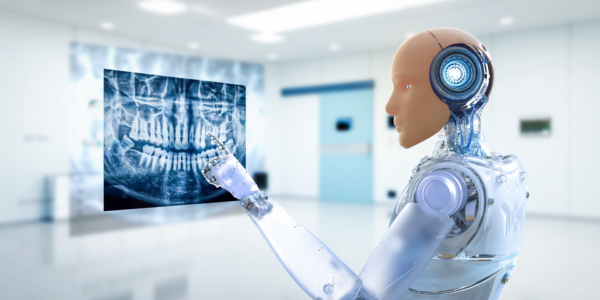We’ve seen robot waiters, robot manicurists, robot rabbis, and robot pharmacists. So why not robot dentists?
Well, because we don’t want a robot anywhere near our mouths, that’s why.
Think again. Dentistry robots start with better imaging of teeth. With a process that’s more like ultrasound with light than like an X-ray, they create a digital plan of the mouth and calculate the precise area and depth of drilling required. The imaging can also be used to prepare dental implants, arch wires, or dental appliances ahead of time.
Currently, impressions are taken and sent off to a lab. The patient returns to have the appliance or impact fitted or installed. With improved digital imaging, the entire procedure could be a one-step process.
Robot hands in human mouths?
Most dentistry robotic devices are essentially worn by the patient, attached directly into the patient’s mouth rather than requiring the patient to stay still while a robotic arm enters the mouth. Since they’re attached to the patient, the possible movement of the head is not a problem. Drilling with robotic devices is expected to be safer and more precise than human drilling.
Several different autonomous robots have been developed and tested with dental implants. Dental implants are by their very nature hard to place. The human mouth is not the best working environment, and placement of a dental implant can require uncomfortable and tiring positions for human dentists. This seems like an obvious case in which automation would be better, and experiments so far seem to support that expectation.
The implant robots make a plan for the patient and guide the dentist’s work, stopping the human dentist if his or her movements deviate from the plan. At the same time, the dentist can clearly see the plan, the scan, and the drill. He or she can adjust the plan through the software if need be. Water sprays, picks, and many other common dentistry tools will no longer be necessary, so the process may be less painful than traditional dentistry.
Disruption?
Just as robot-assisted surgery has allowed surgeons to complete more operations in a shorter time, with greater precision and less fatigue, robot-assisted dentistry could be a boon for dentists.
Dentists may need to acquire new skills related to operating, programming, and maintaining robotic systems. Training and education will become more focused on integrating technology into dental practice. But dentists may also be able to delegate more routine tasks to robots, leaving them more time for complex care or even for human connections with patients.
So far only one dental robotic system is FDA-approved, and it is used for limited tasks. Several more dental robotic systems are in process, but they will need to go through clinical trials and extensive testing before they can go on the market. Experts predict that there will be robot-assisted dentistry available to consumers within the next five years.
In the meantime, when you need service or support for Indramat motion control systems, call us for immediate assistance.
